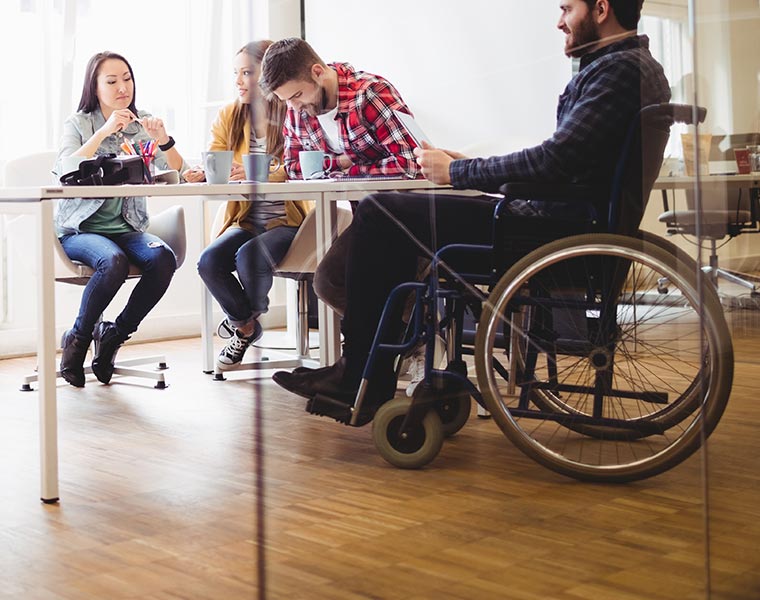A top-level definition of an inclusive workspace would be one that provides equal access and opportunities regardless of variables such as age, gender, race, physical ability and mental health.
Diversity and inclusion in the workplace is often more closely associated to things like HR practices, company policies and training. However, there is now a growing awareness of the impact office design can have on fostering an inclusive workplace.
In an article around the subject of inclusive workspaces, Forbes summarised the concept as the “accessibility and usability of a product”.

In terms of office design:
As space-planners and interior designers, we see commercial interior design, office furniture and technology as the ‘products’ in question…
Therefore, within our industry, an inclusive workspace is making these products more ‘accessible’ and ‘useable’ in light of an increased awareness around the importance of diversity and inclusion through office design.
The characteristics of inclusive workplace design:

Aids those facing physical challenges or disability
You probably don’t need us to tell you that when designing an inclusive workspace, physical challenges and disabilities need to be top of the priority list.
Through a carefully thought out fit out process, product selection and design scheme, a few simple but effective developments can be implemented…
Some examples:
- Making corridors wide enough to accommodate two passing wheelchairs (not just those walking)
- Multi-height surfaces in communal areas such as kitchens and toilets
- Height-adjustable work areas such as sit-stand desks
- Door handles which can be operated using the ‘closed fist’ test
- Installing ramps and lift shafts during Shell & Core fit out
- Install ergonomic furniture which reduces injury and supports a variety of postures

Sensitive to neurodiversity and various mental health issues
Research shows that 1 in 10 full time office workers are considered to be neurodiverse. This means they come under the spectrum of things like dyslexia, dyspraxia and ADHD.
Alongside this, there is also anxiety and other mental health problems which should be considered when designing an inclusive workspace.
A few pieces of advice:
- Think carefully about colours used in décor
- Facilitate agile working for improved job satisfaction and morale
- Include plenty of natural light and biophilic elements to reduce stress levels
- Implement acoustic solutions where noise distraction could be an issue
- Consider a Pet Policy (click for more on the mental health benefits of a pet-friendly office)
Supports equal collaboration, participation and idea-sharing
The main aim of an inclusive workplace is to create a working environment which removes unnecessary barriers to encourages collaboration and participation across a diverse workforce.
This can be done effectively by creating dedicated collaboration spaces and supplying adaptable furniture which can be reconfigured according to task and requirement. However, office technology arguably has the biggest impact on collaborative work.
Technology we would recommend:
- The Google Jamboard – supports a 16-touch point functionality
- ClickShare – enables multiple users to connect and share their screens from various positions
- Mars desktop power – offers 360-degree access for portable connectivity

Acknowledges fluidity in gender and personal identity
Gender and identity are concepts which are become increasingly flexible and fluid. No matter what a business owner’s stance on this, if they want to attract and retain the best new talent, this is something they will need to accommodate.
As well as things like gender, sexuality and lifestyle choices, there is also personality to consider…
A well-designed inclusive workspace will accommodate introverts, extroverts and all the grey areas in between to ensure everybody’s wellbeing is accounted for.
Our top tips:

- Provide a place for privacy as well as collaborative work
- Consider implementing gender neutral toilets
- Create purpose-built social spaces where staff can interact casually and build strong relationships which will encourage them to feel included and speak out if they have any problems
The important thing to remember:
Our physical environment is highly influential when it comes to attitudes, behaviours and wellbeing of those working in it on a regular basis.
More and more companies are expecting their staff to work more diversely and flexibly so businesses need to offer the same open mindedness in return.
Office design has the potential to be an extremely strong communicator of brand values and culture.
So, if you want to be seen as a forward-thinking, inclusive company who embraces and caters for diversity, this needs to be reflected in the design of your workspace.

